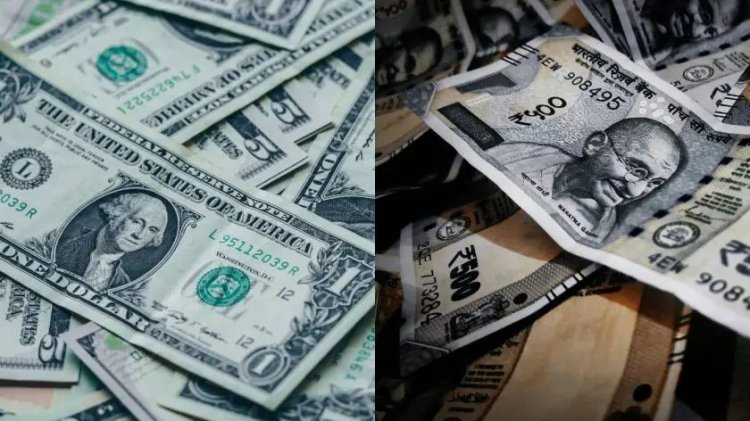Rupee Vs US Dollar: Who Gains & Who Suffers As the Currency Gap Widens?

The Indian rupee reached a record low of ₹86 against the US dollar on January 10, 2025, driven by the strengthening American currency and significant foreign fund outflows. This marked a 14-paise decline in the rupee's value, a situation that has raised concerns about India's economic stability. Several factors contribute to this depreciation, including external and domestic economic pressures.
Factors Behind the Decline of the Rupee
-
Foreign Investor Withdrawal
Foreign investors are pulling capital out of Indian markets, leading to a reduced demand for the rupee. These withdrawals are partly influenced by global economic uncertainties, including the expectation of higher interest rates in the US. -
Rising Crude Oil Prices
As a major importer of crude oil, India needs a substantial amount of US dollars to pay for its energy needs. The rise in crude oil prices increases this demand, putting additional pressure on the rupee. -
Negative Stock Market Sentiment
The Indian stock market has seen a downturn in investor confidence. Concerns about domestic economic growth and inflation have resulted in lower foreign investments, further weakening the rupee. -
US Political Landscape
The anticipation of a new US presidency and potential changes in trade policies has increased global demand for the dollar. This geopolitical uncertainty has further strengthened the US dollar against other currencies, including the rupee. -
Low Export Growth
India's export performance has been subdued, leading to decreased demand for the rupee. This stagnation in export growth hampers the economy's ability to counterbalance rising import costs.
RBI's Intervention to Stabilize the Rupee
The Reserve Bank of India (RBI) is taking measures to stabilize the rupee by utilizing its foreign exchange reserves. By releasing more dollars into the market, the RBI aims to increase the supply of dollars and curb the downward pressure on the rupee. However, this strategy comes at a cost, as it depletes the country’s foreign exchange reserves.
Who Gains & Who Suffers from the Falling Rupee?
The depreciation of the rupee has wide-ranging implications for different sections of the economy, affecting individuals, businesses, and the government in various ways.
Who Gains?
-
Exporters
A weaker rupee makes Indian goods cheaper in global markets, potentially boosting demand for exports. Industries like textiles, IT services, and pharmaceuticals stand to benefit from this competitive advantage. -
Remittance Receivers
Indians working abroad, especially in the US, gain when the rupee weakens. Their dollar earnings fetch higher amounts in Indian rupees upon conversion, increasing the value of their remittances. -
Foreign Tourists
A weak rupee makes India a more affordable travel destination for international tourists. This could boost the country’s tourism sector, benefiting hotels, restaurants, and related businesses.
Who Suffers?
-
Consumers and Businesses Dependent on Imports
- Oil and Energy: India imports over 80% of its crude oil requirements. A weaker rupee increases the cost of these imports, directly impacting fuel prices. Higher petrol and diesel costs lead to inflation, affecting transportation and essential goods.
- Electronics and Machinery: Imported items like smartphones, appliances, and industrial machinery become costlier, burdening consumers and businesses alike.
-
Students Studying Abroad
Indian students planning to study in the US or other dollar-dependent countries face higher expenses. Tuition fees and living costs denominated in dollars increase significantly when converted from a weaker rupee. -
Travelers
Indians traveling abroad face higher costs for accommodation, food, and other expenses due to the unfavorable exchange rate. This makes international travel less affordable for many. -
Government Spending
The government bears a heavier financial burden for its imports, especially oil and defense equipment. A higher import bill adds to the fiscal deficit, which can reduce spending on other critical areas like infrastructure and welfare programs.
Broader Economic Implications
The falling rupee also affects inflation, monetary policy, and economic growth:
- Inflationary Pressures: Higher import costs lead to increased prices for essential goods, putting a strain on household budgets.
- Policy Adjustments: The RBI may consider tightening monetary policy to stabilize the rupee, which could result in higher interest rates, impacting borrowing costs for businesses and individuals.
- Impact on Foreign Investments: A weakening rupee can deter foreign investors from entering Indian markets due to concerns about reduced returns in dollar terms.
Can the Rupee Recover?
Recovering the rupee's value will depend on several coordinated efforts:
-
Boosting Exports
Encouraging export-oriented industries and diversifying into new markets can help create a natural demand for the rupee. -
Attracting Foreign Investment
Policymakers need to focus on creating a favorable investment climate to bring back foreign capital. Simplifying regulations and enhancing economic stability can help achieve this. -
Reducing Dependency on Imports
Investing in renewable energy and domestic manufacturing can lower reliance on imported oil and goods, easing the pressure on the rupee. -
Strengthening Economic Fundamentals
Addressing inflation, fiscal deficits, and structural challenges in the economy will be essential to restore investor confidence and stabilize the rupee.
Conclusion
The falling rupee has both winners and losers. While exporters and remittance receivers stand to benefit, the overall economic impact leans heavily toward challenges, especially for consumers, businesses, and the government. As the currency gap widens, India must focus on long-term structural reforms to reduce dependency on imports, enhance export competitiveness, and attract stable foreign investments. Only through comprehensive measures can the rupee regain its strength and ensure economic resilience in the face of global headwinds.
What's Your Reaction?















